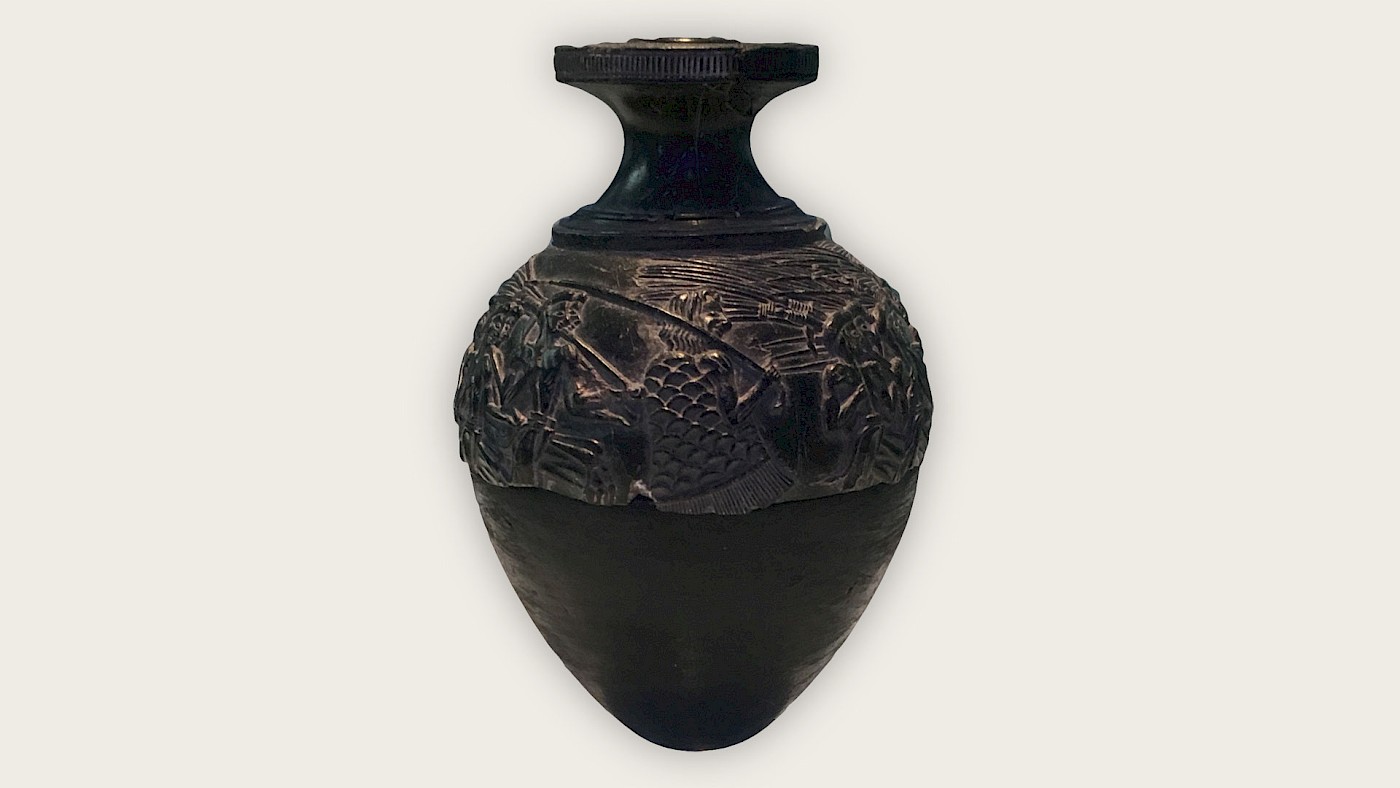Many of the objects in the beautiful archaeological museum of Iraklion are displayed alongside other objects in glass display cases installed along the walls. A few objects get a display case away from the walls and all to themselves, so that visitors are able to walk around them and soak in all the details.
The Phaistos Disc is one of these fortunate objects; the so-called “Harvester Vase”, the subject of this brief article, is another. The object was unearthed at the Minoan administrative centre of Agia Triada, itself located only a short distance from the “palace” (court compound) of Phaistos. The object is made of black steatite (i.e. soapstone) and dated to Late Minoan I; the museum lists an absolute date of ca. 1450 BC. It was found together with the so-called Chieftain Cup, about which I’ll write more in a forthcoming article.
The bottom half of the vase has not survived and was probably made of a different material. The entire vase may have originally been covered by gold leaf. The present lower half is a modern restoration. We know, based on similar vessels, that the vase was originally shaped like an ostrich egg. It is a rhyton, which had a large opening at the top and a small opening at the bottom that could be closed by covering it with a finger. Vessels like this were filled with liquids (e.g. wine, perfumed oil) and used in rituals.
A figured scene in relief
The “Harvester Vase” is relatively small, with a maximum diameter of 11.3 cm; its preserved height is 10.1 cm (reconstructed height is 18 cm). Within the small space available, the maker managed to carve an intricate scene in relief that features no fewer than 27 male figures. Most of the male figures wear breech-clothes and carry either “hoes with willow-shoots attached” (Higgins 1981 [1967], p. 154) or “winnowing fans” (Biers 1996 [1980], p. 57); their heads are covered by caps.
In the midst of these men with the hoes are a group of four men whose heads are bare and their mouths wide open: they are clearly singing, with one of their number, walking in front of the other three, holding a musical instrument known as a sistrum, a type of rattle. Sistra are known from Egypt and the ancient Near East; physical remains of sistra have also been unearthed in Crete.

Especially prominent is a male figure carrying a staff with a hook at the end, a symbol of authority. He is shown wearing a cloak that seems to be covered in scales. Bernice Jones has studied the cloak in detail and found parallels from not just Crete, but also from Ebla in Syria (dated ca. 1750-1700 BC), who also carries a staff with curved end. In her book on Aegean Bronze Age clothing, she offers a very convincing reconstruction of the cloak (pp. 266-269).
This figure – perhaps to be interpreted as a priest or another authorative figure – is further distinguished from the other men in this scene by the fact that he sports long hair. He is depicted as either leading the entire group of men or, depending on one’s point of view, following them. Another figure, facing in the other direction compared to the rest of the men, appears to be a dancer, weaving through the crowd.
Interpretations of the vase differ, but most agree that the scene somehow relates to agriculture. As the modern name suggests, the ritual depicted may be a procession or some kind of dance associated with the harvest (if the agricultural implements are interpreted as winnowing fans) or, alternatively, with sowing and ploughing (if interpreted as hoes, used to loosen up the soil). Sowing of cereals was usually done in the autumn; harvesting took place in spring (Edwards 2004, pp. 150-156).
In their Aegean Art and Architecture, Donald Preziosi and Louise A. Hitchcock point out that the scene on the vase recalls “a propagandistic depiction of either corvée (forced labor) which is well attested in contemporary Near Eastern economies, especially at Mari, or as in the mainland Mycenaean economy where land was provided in exchange for obligatory service” (p. 118, with references).
While obviously not comparable to a photograph, depictions such as this scene on the Harvester Vase nevertheless offer valuable glimpses into what everyday life in Minoan Crete may have been like, nearly 3,500 years ago. The scene is executed with such vigour that one can almost hear the men singing and walking, their hoes (or fans) brushing against each other as they move along.
Further reading
- William R. Biers, The Archaeology of Greece (1996 [1980]).
- Anthony T. Edwards, Hesiod’s Ascra (2004).
- Reynold Higgins, Minoan and Mycenaean Art (1981 [1967]).
- Berenice R. Jones, Ariadne’s Threads: The Construction and Significance of Clothes in the Aegean Bronze Age (2019).
- Donald Preziosi and Louise A. Hitchcock, Aegean Art and Architecture (1998).
